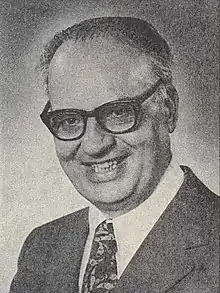Dhikru'llah Khadem
Dhikru'llah Khadem (Arabic: ذكر الله خادم, or Zikrullah Khadem; 1904–1986[1]) was a Iranian follower of the Baháʼí Faith, appointed to a leadership role as a Hand of the Cause in February 1952.[1][2] As a Hand of the Cause, Khadem played a key role in the transition of power in the religion between the death of Shoghi Effendi in 1957 and the establishment of the Universal House of Justice in 1963,[3] including responding to the attempted schism by Mason Remey in 1960.[4]

Khadem worked for a British oil company in Iran and had a mastery of English that he used to translate English works into Persian. He also compiled 134 volumes documenting Baháʼí holy places.[1]
Khadem travelled extensively around the world for Shoghi Effendi, head of the Baháʼí Faith from 1921-1957. He visited many parts of Iran,[1] and over 50 countries including Canada, Malaysia and Japan.[5][6]
Background
Khadem was born in Tehran in 1904, the second child of Nasru'lláh and Rádiyyih.[7] His father served ʻAbdu'l-Bahá in ʻAkká in the 1890s and received the title ʻKhádim (servant) from him. Zikrullah taught briefly at the Tarbiyat Baháʼí school school in Tehran, then worked for the Anglo-Persian Oil Company as an interpreter, teaching Persian to the English-speaking employees, then was appointed as the personal assistant to the British general manager of the company.[7]
Zikrullah first went on pilgrimage to the Baháʼí World Centre in 1925, meeting Shoghi Effendi and assisting with some of the layout of the Shrine of the Báb.[7] In 1930 he left the oil company to work at the Iraqi embassy in Tehran until 1944. He married Javidukht on 3 October 1933, and had five children: Mozhan, Jena, Riaz, Ramin and May.[7] Along with his new wife, throughout the 1930s he travelled around Iran visiting nearly every city on assignments for Shoghi Effendi, such as visiting new believers and photographing sites of historical significance. While visiting Nayriz, he was temporarily jailed.[7]
Khadem served on the National Spiritual Assembly of the Baháʼís of Iran from 1938 to 1960,[1] and served as its treasurer in the 1950s.[7][8] Between 1940 and 1957, Khadem was the main conduit for communications from Shoghi Effendi to the Baháʼí institutions and individuals in Iran; including during WWII when there was no postal service, when he had to charter private planes to move mail.[7]
As a Hand of the Cause
In February of 1952 Khadem received a notice from Shoghi Effendi appointing him as a Hand of the Cause, the highest appointed role in the religion after Shoghi Effendi. Only 50 were ever appointed. He subsequently left Iran and worked full-time for Shoghi Effendi, travelling extensively around the world to over 50 countries from 1953 to 1963, and over 1,000 Baháʼí communities.[7] For example, in 1955, at the first Baháʼí teaching conference in Asia in Nikko, Japan, Khadem was Shoghi Effendi's representative.[9]
The religion went through a severe crisis from 1957 to 1963.[10] Shoghi Effendi died on 4 November 1957 without having appointed a successor, and the 27 living Hands gathered in a series of 6 secret conclaves (or signed agreements if they were absent) to decide how to navigate the uncharted situation.[11] They made an announcement on 25 November 1957 to assume control of the Faith, certified that Shoghi Effendi had left no will or appointment of successor, said that no appointment could have been made, and elected 9 of their members to stay in at the Baháʼí World Centre in Haifa to exercise the executive functions of the Guardian (these were known as the Custodians).[11] For several months in 1958 Zikrullah Khadem substituted as a member of the nine custodial Hands in Haifa, then continued travelling.[7]
As early as January 1959, Mason Remey, one of the custodial Hands, believed that he was the second Guardian and successor to Shoghi Effendi.[12] That summer after a conclave of the Hands in Haifa, Remey abandoned his position and moved to Washington D.C., then soon after announced his claim to absolute leadership, causing a schism. In late 1959 Khadem dedicated himself to moving to the western hemisphere to help resolve the crisis, but it took him almost a year to resolve affairs in Iran before he moved to the United States in 1960.[7][1] For some time he was the only Hand serving throughout north and south America while Remey was trying to draw Baháʼís into his own schismatic group, whose followers were mostly in the United States.[13]
In 1963 Khadem attended the election of the Universal House of Justice,[7] then the custodial Hands of the Cause closed their office. Khadem encouraged Baháʼís to be obedient to the new institution. In 1972 the Universal House of Justice asked Khadem to research and document places and people of historical significance to Baháʼís. In 1977 his research concluded with a 134-volume work that was submitted to the Universal House of Justice.[7]
He died on the morning of 13 November 1986.[7]
Notes
- Smith 2000.
- Rabbani 1997, p. 254.
- Hartz 2009, p. 84-85.
- Johnson 2020.
- Effendi 1998, p. 276.
- Effendi 1970, p. 226.
- Harper 1997.
- Rabbani 1992, p. 28.
- Sims 1989, p. 138-143.
- Johnson 2020, p. xxx.
- Johnson 2020, p. 8-18.
- Johnson 2020, p. 26-27.
- Smith 2000, p. 292.
References
- "In Memoriam: Hand of the Cause Zikrullah Khadem" (PDF). Baháʼí News No. 669. National Spiritual Assembly of the Baháʼís of the United States. December 1986. pp. 2–7. Retrieved 2021-02-05.
- Effendi, Shoghi (1970). Dawn of a New Day. India: Baháʼí Publishing Trust. p. 226.
- Effendi, Shoghi (1998). "Letter of 18 September 1957". Messages to Canada. Baháʼí Canada Publications. p. 276. ISBN 0-88867-112-1.
- Johnson, Vernon (2020). Baha'is in Exile: An Account of followers of Baha'u'llah outside the mainstream Baha'i religion. Pittsburg, PA: RoseDog Books. ISBN 978-1-6453-0574-3.
- Harper, Barron (1997). "Zikrullah Khadem (Dhikru'llah Khadim)". Lights of Fortitude (Paperback ed.). Oxford, UK: George Ronald. pp. 362–371. ISBN 0-85398-413-1.
- Hartz, Paula (2009). World Religions: Baha'i Faith (3rd ed.). New York, NY: Chelsea House Publishers. ISBN 978-1-60413-104-8.
- Khadem, Javidukht (1990). Zikrullah Khadem: The Itinerant Hand of the Cause of God. Baha'i Publishing Trust of the United States. ISBN 0-87743-225-2.
- Rabbani, Rúhíyyih (1969). The Priceless Pearl (Hardcover ed.). London, UK: Baháʼí Publishing Trust: 2000. p. 254. ISBN 1-870989-91-0.
- Rabbani, Rúhíyyih, ed. (1992). The Ministry of the Custodians 1957–1963. Baháʼí World Centre. ISBN 0-85398-350-X.
- Sims, Barbara R. (1989). Traces that Remain: A Pictorial History of the Early Days of the Baháʼí Faith Among the Japanese. Japan: Baháʼí Publishing Trust. pp. 138–143.
- Smith, Peter (2000). "Zikrullah Khadem". A Concise Encyclopedia of the Baháʼí Faith. Oxford, UK: Oneworld Publications. p. 217. ISBN 1-85168-184-1.
External links
- The Khadem Foundation, a non-profit organization founded in 2004 and inspired by the work of Zikhrullah Khadem.
- Zikhrullah Khadem at Find-a-Grave.com
